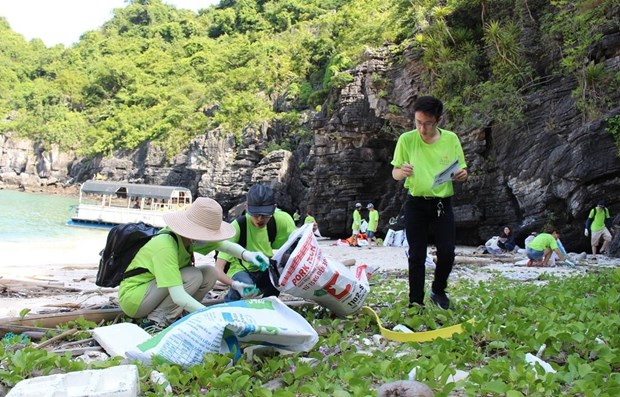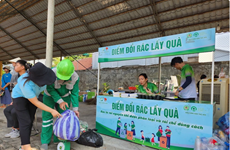Workshop calls for actions against plastic waste in Ha Long Bay
A workshop was held in Ha Long city, northern Quang Ninh province, on August 26 with the aim of promoting public awareness of marine plastic waste and actions against single-use plastic products in Ha Long Bay, a world natural heritage site.
 Volunteers collect waste on an island in Ha Long Bay. (Photo: VNA)
Volunteers collect waste on an island in Ha Long Bay. (Photo: VNA)An estimate in 2020 by the Ending Plastic Pollution Innovation Challenge (EPPIC) project showed that among over the 28,280 tonnes of plastic waste released in the Ha Long Bay area each year, about 5,272 could be discharged to the sea, and 34 tonnes of waste came from tourism activities every day.
Patrick Haverman, Deputy Resident Representative of the UN Development Programme (UNDP) in Vietnam, said plastics accounts for an estimated 70 - 80% of marine debris. While many countries have made considerable efforts to fight plastic waste, challenges caused by marine plastics are transboundary.
Under a Norwegian Embassy-funded project on scaling up community-based models of domestic waste and plastics management, the UNDP has developed integrated, green, and equal models for improving the domestic waste management system. It has also worked with the Ministry of Natural Resources and Environment to carry out the EPPIC project in four ASEAN countries, namely Vietnam, Thailand, Indonesia, and the Philippines, he noted.
Nguyen Van Duong, Vice Chairman of the Quang Ninh Farmers’ Union, said environmental protection requires the engagement of the entire political system, society, businesses, and the community, adding that each people’s awareness is the most important factor.
Tourism has a great role to play in protecting the marine environment as many of the vessels operating at sea belong to the industry, he went on, holding that a system of all-round solutions is necessary for mitigating adverse impacts of plastic waste.
Duong noted a project has been implemented in the areas bordering Ha Long Bay since 2020 to build a community-based model of waste management, sorting, collection, and treatment. The project, funded by the UNDP, the Global Environment Facility, and the Norwegian Government, has helped improve local authorities, businesses and residents’ awareness and capacity.
At the workshop, participants shared views on marine environmental protection, the role of each organisation in boosting sustainable tourism, and activities carried out in localities to ease impacts of tourism vessels and single-use plastic products on the environment.
On this occasion, the UNDP debuted “Trash Hunt” (http://sanrac.undp.org.vn), a mobile app to report and monitor all indiscriminate dumping sites in Vietnam so that local authorities, related parties, and residents can make timely response.
In 2011, Ha Long Bay, literally “descending dragon bay”, surpassed more than 400 destinations from over 200 countries and territories to be named as one of the New 7 Wonders of the World by the organisation New Open World. The bay was recognised twice by the UNESCO as World Natural Heritage for its landscape and geographical value.
Earlier this year, a shop of the “Ending Plastic Pollution Innovation Challenge” (EPPIC) which displays innovative products and services aimed at reducing plastic pollution was opened in Ha Long city.
This activity looks to assist innovative solutions for environmental protection to be implemented in reality so as to improve local residents’ awareness and behaviours relevant to single-use plastic items.
The items on show, made from environmentally friendly materials, were among the winners of the EPPIC competition for the ASEAN region, which sought solutions to plastic pollution in Ha Long Bay of Vietnam and Samui Island of Thailand. This contest was organised by the United Nations Development Programme (UNDP) and the Vietnam Administration of Seas and Islands (VASI), with support from the Norwegian Government.
An estimated 3.1 million tonnes of plastic waste is discharged on land in Vietnam, and at least 10% of this goes into the ocean every year. The Vietnam National Plastics Action Partnership said the amount of plastic in waterways can more than double by 2030 if the country’s current waste collection, recycling, and treatment processes are not improved./.












